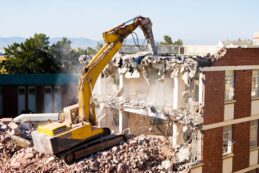
A 19-year-old temp is handed a power drill on his first day at a construction site. No training, no briefing, just a nod toward the scaffolding. A week later, he’s in the ER with a fractured wrist. No one’s surprised. No one’s accountable.
Temporary and seasonal workers are often the first to face danger and the last to receive proper training. In fact, 34% of workplace injuries occur during an employee’s first year on the job. This is a risk amplified for temps who are “new” multiple times a year.
This guide breaks down how OSHA 10 certification can protect temporary and seasonal workers—and why both staffing agencies and host employers are legally responsible for making sure it happens.
An Overview of OSHA 10 Certification
An OSHA 10 certification is an outreach training program in the United States that provides basic safety and health information to entry-level workers. These professionals work in both construction and general industries. The certificate helps you learn how to identify, avoid, and prevent job-related hazards, understand worker rights, and know how to file an OSHA complaint if needed.
The 10-hour safety program is developed by the OSHA authorities and helps workers recognize, avoid, and prevent workplace hazards. This involves learning the OSHA sign requirements and proper hazard communication.
According to the U.S. Department of Labor, the program trained over 5.21 million workers to recognize and avoid workplace hazards between FY 2016 and FY 2020.
Key Industries Where OSHA 10 is Needed for Seasonal Workers
OSHA 10 certification plays a key role in preparing seasonal workers to recognize hazards, follow safety protocols, and respond effectively to emergencies. Let’s take a closer look at the key industries where OSHA 10 training is beneficial for workers.
Construction
Construction sites pose high risks because of heavy machinery, working at heights, and electrical systems. OSHA 10 provides workers with proper knowledge on fall protection, PPE, and hazard communication to reduce job site injuries.
Warehousing and Logistics
Seasonal workers in warehouses often deal with forklifts, lifting equipment, and fast-paced environments. OSHA 10 training covers safe material handling, ergonomics, and equipment safety to prevent musculoskeletal injuries and accidents.
Hospitality and Food Processing
Workers in these sectors may face slips, cuts, burns, or chemical exposures. OSHA 10 helps them understand hygiene standards, chemical handling, and fire safety.
Benefits of OSHA 10 Certification for Seasonal Workers
Consider a temporary warehouse worker who was certified through OSHA 10. During a shift, he notices a stack of boxes teetering near a busy walkway. Remembering the “Struck-by Hazards” module from training, he immediately alerts a supervisor and cordons off the area.
His quick action prevents a potential injury, not just for himself, but for several coworkers. This is the kind of real-world impact OSHA 10 certification can have. Its additional benefits are:
Improved Employability
Many employers prioritize or even require OSHA 10 certification. Being certified could be the difference between getting the job and losing out to someone else. It shows initiative and a basic understanding of workplace safety to ensure candidates are more appealing during the hiring process.
Improved Job Site Confidence
Trained workers are more confident, proactive, and less likely to cause or be involved in accidents. This boosts overall productivity and team morale. It also means workers are more equipped to speak up and take preventive action due to a clear understanding of potential hazards.
Long-Term Career Investment
Even if the role is short-term, OSHA 10 certification remains valid and can help workers land future roles in similar industries. It serves as a stepping stone for higher-level certifications and opens doors to more specialized, better-paying positions.
Steps to Obtain OSHA 10 Certification
If a temporary worker gets injured and lacks proper safety training, the employer may be held liable. Ensuring OSHA 10 certification can showcase due diligence and help mitigate legal risk. It means the workers already know how OSHA enforces its standards and comply with them accordingly. On that note, here are the steps to follow when obtaining your OSHA 10 certification.
Determine the Right OSHA 10 Course for Your Industry
OSHA offers two types of 10-hour training programs: one for the Construction Industry and one for General Industry (covering manufacturing, warehousing, healthcare, and more). Choose the course that aligns with your job role or work environment to ensure relevance.
Enroll Through an Authorized OSHA Training Provider
Only OSHA-authorized outreach trainers or institutions are permitted to deliver these courses. You can take the training online or in person, depending on your preference. Be sure to verify the provider’s credentials before registering.
Complete the Full 10 Hours of Training
The course covers safety topics such as hazard recognition, fall protection, electrical safety, personal protective equipment (PPE), and workers’ rights. You must complete all sessions and cannot skip content because OSHA requires full attendance for certification.
Pass Course Assessments and Final Exam
You will take quizzes or module-based assessments throughout your time. At the end, you must pass a final exam to showcase your understanding of workplace safety standards and practices.
Receive Your OSHA 10 Card
Once you pass the course, the provider will process your official Department of Labor (DOL) OSHA 10 card. It usually arrives by mail within 2 to 4 weeks and serves as proof of your safety training with an authorized institute.
Common Misconceptions About OSHA 10 Certification
The OSHA 10 certification is a popular training course for temporary and seasonal workers in the United States. However, there are several misconceptions associated with the training that must be debunked to highlight the correct facts. These are:
A Mandate for Construction Workers
Many believe that the OSHA 10 certification is compulsory for construction workers. However, despite being widely encouraged in the U.S., it is not a federal requirement for workers to pursue training. OSHA itself does not mandate this type of training for construction workers.
OSHA 10 Covers All Safety Topics
There is a misconception that the OSHA 10 certification covers all key safety topics covering hazards and in-depth scenarios.
This leads to several workers thinking that they can become experts in workplace safety. However, OSHA 10 is only an entry-level course and workers must take the OSHA 30 certification for more in-depth knowledge about hazards and safety.
OSHA 10 Certification Never Expires
Many people believe that the OSHA 10 card that they receive is valid for a lifetime. However, there is a set expiry date for this certification, which means workers must renew it based on the compliance requirements as and when needed.
Prevent Workplace Hazards with OSHA 10 Certification
Temporary or seasonal work shouldn’t mean sacrificing safety. The OSHA 10 certification equips you with the tools and knowledge to protect yourself and those around you. It teaches the rules and regulations related to both employers and employees working in construction, warehousing, logistics, and other general industries. This allows you to prevent potential workplace hazards while working in these places.
Investing in OSHA 10 training is a proactive step toward creating a culture of safety for employers and staff agencies. Make sure to learn the steps associated with it to earn your card on time. This will also allow you to debunk all misconceptions associated with the course. On that note, if you want to learn more about workplace safety hazards and prevention, enroll in an OSHA 10 certification now.













